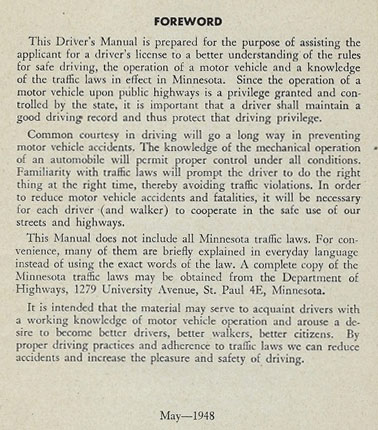Drive Like it's 1948?

While going through some boxes of old family photos, diplomas, and other items that my parents saved for some reason, I came across a Minnesota Driver’s Manual. Curiosity got the best of me… that’s why cleaning out parent’s homes takes so long. This manual is dated 1948 and provided an interesting window to the past. Despite the passage of 71 years, the messages regarding driving safety remain pertinent today. 
The foreword was the first page to catch my eye. Driving safely certainly isn’t a new idea. As stated, “In order to reduce motor vehicle accidents and fatalities, it will be necessary for each driver (and walker) to cooperate in the safe use of our streets and highways.” I couldn’t have said it any better myself.
However, in many ways our lifestyles have changed dramatically over the years. We now seem to be more pressed for time and everyone is in a hurry. Although connected electronically we are less connected personally. Cell phones and social media seem to be more important than engaging in behaviors that will help improve everyone’s safety; driving a safe speed, yielding to pedestrians, and concern for others to name a few. Again quoting from 1948, “Common courtesy in driving will go a long way in preventing motor vehicle accidents.”
Technology is another area in which there has been dramatic change over the years. Today’s vehicles provide vastly better survivability than the relatively primitive vehicles of 1948. According to the National Safety Council, the fatality rate in 1948 was 8.11 per 100,000,000 miles driven. In 2017 that number was down to 1.25. Cutting the fatality rate by over six times is a significant success. Having said that, the fatality rate in the years 2014-2016 rose each year. This increasing fatality rate, in three consecutive years, has happened only three times since 1948. So as engineering continues to make our cars safer and more occupants are using their seat belts, the fatality rate continued to rise. 2017 showed some promise with a slight decrease from 2016 (1.27 to 1.25).
Nearly all traffic accidents are caused by human error. There are a few outliers- mechanical failure, animals in the road, structure collapse, etc… But the vast majority come down to a driver or a pedestrian or a cyclist failing to take the necessary actions to avoid the collision. Fatigue, distraction, speed, impairment, and all varieties of road rage all play a part in these terribly sad events. Killing over 40,000 people and injuring over 2 million more each year is simply unacceptable. Each driver and each business owner who has employees on the road is responsible to ensure the safe operation of their cars, vans, and trucks. If your business doesn’t have a comprehensive Fleet Plan, it should. MEMIC can assist with sample plans, templates, and other transportation safety tips. Simply access the Safety Director to find out how to better control this exposure.
To sum up, I again refer to how earlier generations put this problem into perspective. “By proper driving practices and adherence to traffic laws we can reduce accidents and increase the pleasure and safety of driving.”
By Randy Klatt

